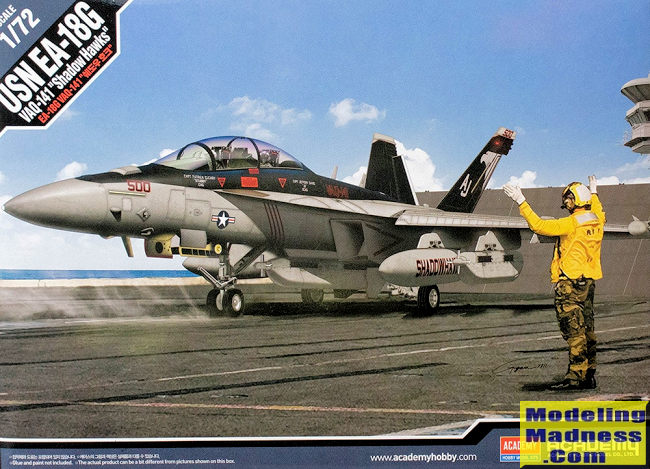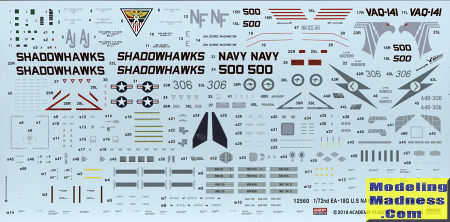
| KIT #: | 12560 |
| PRICE: | $27.00 shipped from Korea |
| DECALS: | Three options |
| REVIEWER: | Scott Van Aken |
| NOTES: | 2018 boxing |

| HISTORY |
The Boeing EA-18G Growler is an American carrier-based electronic warfare aircraft, a specialized version of the two-seat F/A-18F Super Hornet. The EA-18G replaced the Northrop Grumman EA-6B Prowlers in service with the United States Navy. The Growler's electronic warfare capability is primarily provided by Northrop Grumman. The EA-18G began production in 2007 and entered operational service with the US Navy in late 2009. Australia has also purchased twelve EA-18Gs, which entered service with the Royal Australian Air Force in 2017.
The first Growler for fleet use was officially accepted by VAQ-129 "Vikings" at NAS Whidbey Island, on 3 June 2008. The Navy planned to buy approximately 85 aircraft to equip 11 squadrons as of 2008. The EA-18G completed operational evaluation in late July 2009. The Growler was rated operationally effective and suitable for operational use. On 5 August 2009, EA-18G Growlers from Electronic Attack Squadron 129 (VAQ-129) and Electronic Attack Squadron 132 (VAQ-132) completed their first at-sea carrier-arrested landing aboard the USS Harry S. Truman (CVN-75).
The first deployable EA-18G squadron was VAQ-132 "Scorpions", which reached operational status in October 2009.The first Growler operational deployment was announced on 17 February 2011. In service, the EA-18's radio name during flight operations will be "Grizzly". The "Growler" nickname sounded too much like the EA-6B's "Prowler" name, so "Grizzly" will be used to avoid confusion. By May 2011, 48 Growlers had been delivered to the U.S. Navy.
With the termination of the EB-52H standoff jammer, the Growler became the sole remaining manned tactical jammer. Air Staff requirements director Maj. Gen. David Scott has indicated that the USAF will seek to provide electronic warfare officers to fly on U.S. Navy Growlers, without providing funding to purchase additional aircraft. U.S. Air Force personnel of 390th Electronic Combat Squadron stationed at NAS Whidbey Island have been supporting and flying the Growler.
The EA-18G was first used in combat during Operation Odyssey Dawn, enforcing the UN no-fly zone over Libya in 2011. Five EA-18Gs were redeployed from Iraq to support operations in Libya in 2011.
| THE KIT |
 Since Academy
had put the bucks into the F-18E/F Super Bugs, it wasn't much of a stretch for
them to do the EA-18G. Just a couple of additional sprues for the wing tip pods
and the jamming pods.
Since Academy
had put the bucks into the F-18E/F Super Bugs, it wasn't much of a stretch for
them to do the EA-18G. Just a couple of additional sprues for the wing tip pods
and the jamming pods.
As with the E/F kits you start by assembling the upper fuselage. This contains the upper wings and part of the lower. There are two lower wing/lerex pieces to put in place. You also have to fill in the guns and cut a section in the wings near the wing fold for some antennas. In addition, the undernose vents need filled and a large, square antenna needs to be removed. The instructions show all the mods you need to make.
There is a rear lower fuselage section that includes the main gear and the gear wells are a separate piece. You are also required to build up the engine intakes and install the landing gear legs prior to trapping the horizontal stab when attaching the upper and lower fuselage sections.
It is only then that you move on to the cockpit. This is the standard two seat tub with a two piece seat and control stick along with an instrument panel. There are five small decals to fit on the panel with one each for the side consoles. The lower forward fuselage also includes the nose gear well.
The nose is more than just the radome; basically everything forward of the lerex and a single piece. There is a one-piece windscreen/canopy. To complete the airframe, you build up and install the nose gear, attach all the gear doors and the wheels. The wing tip pods are in place of the missile rails.
A supplemental instruction sheet covers the
installation of the 'things under wings'. All the holes for attaching the pylons
are already open and quite large. In the case of this aircraft, this means a
pair of fuel tanks for the wings as well as a pair of jamming pods. One pod fits
on the centerline as well. Outer pylons are provided and
 you must cut
the missile rails from them. No missiles are provided for these. On the upper
fuselage and wings there are additional antennas and strakes that need to be
added. For some of these, holes will need to be opened early in the build.
you must cut
the missile rails from them. No missiles are provided for these. On the upper
fuselage and wings there are additional antennas and strakes that need to be
added. For some of these, holes will need to be opened early in the build.
Instructions are very nicely drawn and you have three options. Two are for planes from VAQ-141. Actually, they are both the same plane, which is the CAG bird. One from 2010 and the other from 2014. They differ only by air wing tail codes and ship names. The third is a 6 Squadron RAAF plane. The decals look to be very nicely done and if you don't like that scheme, there are a ton of aftermarket options.
| CONCLUSIONS |
Well, I have to say that the parts breakdown is a bit unconventional for Hornets from other kit makers, but it does work fairly well. The large pylon attachment points will gain marks from many modelers as will the general simplification of the kit. Others won't like the pre-drilled holes or the one-piece canopy. Still, if super bugs in this scale are something you like building, then this is probably a good choice.
| REFERENCES |
Copyright ModelingMadness.com. All rights reserved.
If you would like your product reviewed fairly and fairly quickly, please contact the editor or see other details in the Note to Contributors.
Back to the Main Page Back to the Review Index Page Back to the Previews Index Page